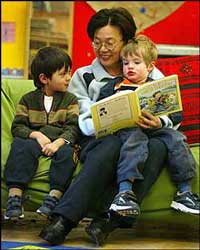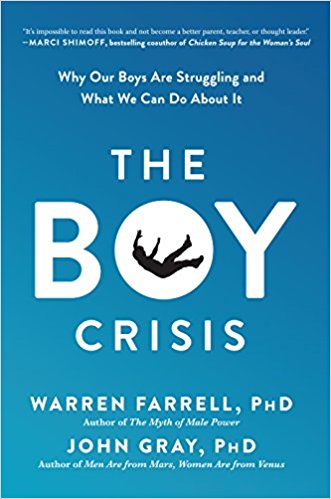![]()
Canada's largest newspaper
Child care to get $5B boost
Five-year plan aims to create national program
Ottawa promises first $700 million without strings
The Toronto Star, by Laurie Monserbraaten, Staff Reporter, Feb. 24, 2005
OTTAWA—The first $700 million of Ottawa's long-awaited $5 billion national child-care initiative goes to the provinces this year with no strings attached.
The money, to be paid through a third-party trust and available to provinces according to population, is a sign of "good faith" while federal, provincial and territorial governments continue to negotiate a formal funding agreement, Social Development Minister Ken Dryden said.
Dryden was hoping to secure a deal in Vancouver earlier this month, but his provincial and territorial counterparts balked, saying they wanted to see Ottawa's financial commitment in the budget before signing on.

Early childhood education teacher Christine Leslie reads with Marco, left, and Finn as parents and child-care providers watch Finance Minister Ralph Goodale deliver his budget on television in the library at Withrow Park Public School in Toronto yesterday
"Most of the jurisdictions were very, very close in terms of an agreement," Dryden told reporters yesterday. "With this commitment, with this trust fund, with this money, we're on the ground."
Dryden expects the agreement to be final in several months.
As expected, the budget allocates $5 billion over five years to begin building a national system of early learning and child care.
Beyond this year's $700 million pledge, the budget allocates $700 million for next year and then ramps up spending to $1.2 billion a year for the last three years. Ontario's share is about $300 million this year.
Although the budget didn't say how much federal money would be available beyond 2010, Finance Minister Ralph Goodale suggested Ottawa is committed for the long term.
Of the total $5 billion committed, $100 million will go to natives on reserves and another $100 million will be spent on an independent "accountability package" to support research into measuring quality and tracking progress of various provincial initiatives.
About 70 per cent of Canadian mothers of children under six are working, but just 20 per cent of young children have access to regulated child-care spaces.
"There can be no Read More ..portant commitments than those we make to our children," Goodale said. "A good start in their earliest years can level the playing field, inspire confidence, foster life skills, encourage ambition and make possible greater goals."
Child-care advocates and federal opposition critics applauded the government for its "historic" financial commitment to child care. But they criticized the lack of accountability for Ottawa's initial $700 million investment this year.
"By beginning with one of the least accountable funding mechanisms, it's not a good starting point," said Kerry McCuaig of the Better Child Care Education Foundation.
"We're pleased that a minority government has actually delivered a national child-care program," said NDP MP Tony Martin (Sault Ste Marie). But he slammed the plan for its lack of accountability in the first year.
TEDx Dr Warren Farrell
TEDx - The Boy Crisis: Why Our Boys Are Struggling and What We Can Do About It
One of the foremost speakers and thinkers on gender issues
It's a crisis of education. Worldwide, boys are 50 percent less likely than girls to meet basic proficiency in reading, math, and science.
It's a crisis of mental health. ADHD is on the rise. And as boys become young men, their suicide rates go from equal to girls to six times that of young women.
It's a crisis of fathering. Boys are growing up with less-involved fathers and are more likely to drop out of school, drink, do drugs, become delinquent, and end up in prison.
It's a crisis of purpose. Boys' old sense of purpose-being a warrior, a leader, or a sole breadwinner-are fading. Many bright boys are experiencing a "purpose void," feeling alienated, withdrawn, and addicted to immediate gratification.
So, what is The Boy Crisis? A comprehensive blueprint for what parents, teachers, and policymakers can do to help our sons become happier, healthier men, and fathers and leaders worthy of our respect.

Why boys are in trouble
Boys have been painted as the bad guys in the push to encourage girls to succeed, leaving many young men feeling confused and alienated, wondering what they did wrong
The Associated Press
January 5, 1999
According to psychologist and author William Pollack, 'sports are the one arena in which many of society's traditional strictures about masculinity are often loosened, allowing boys to experience parts of themselves they rarely experience elsewhere.'
When Harvard Medical School psychologist William Pollack administered a test to a group of 150 teenaged boys a few years ago, the results were shocking.

The Boy Crisis Book
The Boy Crisis: Why Our Boys Are Struggling and What We Can Do About It
Authors- Waren Farrell PhD and John Gray PhD
What is the boy crisis?
It's a crisis of education. Worldwide, boys are 50 percent less likely than girls to meet basic proficiency in reading, math, and science.
It's a crisis of mental health. ADHD is on the rise. And as boys become young men, their suicide rates go from equal to girls to six times that of young women.
It's a crisis of fathering. Boys are growing up with less-involved fathers and are more likely to drop out of school, drink, do drugs, become delinquent, and end up in prison.
It's a crisis of purpose. Boys' old sense of purpose-being a warrior, a leader, or a sole breadwinner-are fading. Many bright boys are experiencing a "purpose void," feeling alienated, withdrawn, and addicted to immediate gratification.
So, what is The Boy Crisis? A comprehensive blueprint for what parents, teachers, and policymakers can do to help our sons become happier, healthier men, and fathers and leaders worthy of our respect. Read More ..

Health Canada Publication
The Invisible Boy: Revisioning the Victimization of Male Children and Teens
"... the existence of a double standard in the care and treatment of male victims, and the invisibility and normalization of violence and abuse toward boys and young men in our society.
Despite the fact that over 300 books and articles on male victims have been published in the last 25 to 30 years, boys and teen males remain on the periphery of the discourse on child abuse.
Few workshops about males can be found at most child abuse conferences and there are no specialized training programs for clinicians. Male-centred assessment is all but non-existent and treatment programs are rare. If we are talking about adult males, the problem is even greater. A sad example of this was witnessed recently in Toronto. After a broadcast of The Boys of St. Vincent, a film about the abuse of boys in a church-run orphanage, the Kids' Help Phone received over 1,000 calls from distraught adult male survivors of childhood sexual abuse. It is tragic in a way no words can capture that these men had no place to turn to other than a children's crisis line."
American Psychological Association
Dating Violence Statistics in the United States
Nearly one in 10 girls and one in 20 boys say they have been raped or experienced some other form of abusive violence on a date, according to a study released Sunday at the annual meeting of the American Psychological Association.
![]()
The mean T-shirt: From the Stupid Factory
Todd Goldman says his popular boy-bashing T-shirts are simply funny.
So why are retailers having second thoughts? Read More ..

Why boys are in trouble
Boys have been painted as the bad guys in the push to encourage girls to succeed, leaving many young men feeling confused and alienated, wondering what they did wrong
The Associated Press
According to psychologist and author William Pollack, 'sports are the one arena in which many of society's traditional strictures about masculinity are often loosened, allowing boys to experience parts of themselves they rarely experience elsewhere.'
When Harvard Medical School psychologist William Pollack administered a test to a group of 150 teenaged boys a few years ago, the results were shocking.
![]()
Where the boys are
The Globe and Mail
February 1, 2003
Academically, boys across the country are lagging behind the girls, but a Montreal public school has seen dramatic improvement by separating the sexes in classes. It allows teachers to tailor curriculum and style to suit each sex. The result? The number going on to college has nearly doubled. INGRID PERITZ reports
MONTREAL -- The teenage girls at James Lyng High School like to flirt with boys. They like to tease them, joke with them, even date them sometimes. But attend class with them? As the giggling girls in one math class this week might say, "Gross."
Luckily, they don't have to. Coed James Lyng splits boys and girls up at the classroom door. The division of the sexes is credited with helping turn a faltering inner-city high school into an education success story.


